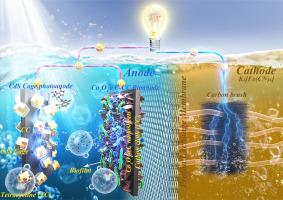Journal of Materials Science & Technology ( IF 11.2 ) Pub Date : 2023-06-16 , DOI: 10.1016/j.jmst.2023.05.018
Z.S. Yuan , J.X. Zou , X.L. Zhao , J.Y. Shi , C.S. Guo , M. Yan

|
Tetracycline (TC) as a common broad-spectrum antibiotic, has been frequently detected in soil and surface water. It becomes a great threat to the ecological environment. Here, a device of photocatalysis assisted microbial fuel cell (photo-MFC) was constructed for TC degradation and energy recovery. In this photo-MFC, cadmium sulfide(CdS) cage photocatalysis can degrade most of TC in a short time. While the Co3O4@C–CC (carbonization and calcination of the ZIF-67 precursor in-situ grown on the carbon cloth (CC)) bioanode degrades the rest of TC as well as the photocatalytic products, thus improving the mineralization. The co-existence of photocatalysis with bioanode changes the microbial community structure of the biofilms. The dominant phylum is Geobacter (60.2%) in normal MFC while that in photo-MFC are Proteobacteria (43.5%) and Geobacter (33.2%). Therefore, the synergistic effect of photocatalytic degradation and biodegradation achieves a chemical oxygen demand (COD) removal of 98.6%, which is higher than that of normal MFC (77.6%) or single CdS cage photocatalysis (23.8%). In addition, the photogenerated electrons can be transferred to the cathode, which reduces their combination with holes and increases the electricity generation of MFC, achieving a maximum power density of 3.37 W/m2. After degradation, the effluent with 200 mg L−1 TC exhibits no visible biotoxity. Furthermore, electrochemical test, finite-difference time-domain (FDTD), density functional theory (DFT) calculation and the free radical trapping experiments verify the possible mechanisms of photocatalytic degradation in this photo-MFC. This strategy paves a new way for low energy consumption removal and energy recovery of organic pollutants.
中文翻译:

硫化镉笼光催化耦合电活性生物膜协同促进四环素降解和发电
四环素(TC)作为一种常见的广谱抗生素,在土壤和地表水中经常被检测到。它对生态环境造成巨大威胁。这里,构建了光催化辅助微生物燃料电池(photo-MFC)装置,用于TC降解和能量回收。在这种光MFC中,硫化镉(CdS)笼光催化作用可以在短时间内降解大部分TC。而Co 3 O 4 @C–CC(在碳布(CC)上原位生长的ZIF-67前体的碳化和煅烧)生物阳极会降解其余的TC以及光催化产物,从而改善矿化。光催化与生物阳极的共存改变了生物膜的微生物群落结构。优势门是地杆菌门正常MFC中的细菌(60.2%),而光MFC中的细菌是变形菌(43.5%)和地杆菌(33.2%)。因此,光催化降解和生物降解的协同效应实现了化学需氧量(COD)去除率98.6%,高于普通MFC(77.6%)或单一CdS笼光催化(23.8%)。此外,光生电子可以转移到阴极,减少了它们与空穴的结合,增加了MFC的发电量,实现了3.37 W/m 2 的最大功率密度。降解后,出水含200mg·L −1TC 没有表现出明显的生物毒性。此外,电化学测试、时域有限差分(FDTD)、密度泛函理论(DFT)计算和自由基捕获实验验证了该光MFC光催化降解的可能机制。该策略为有机污染物的低能耗去除和能量回收开辟了新途径。































 京公网安备 11010802027423号
京公网安备 11010802027423号